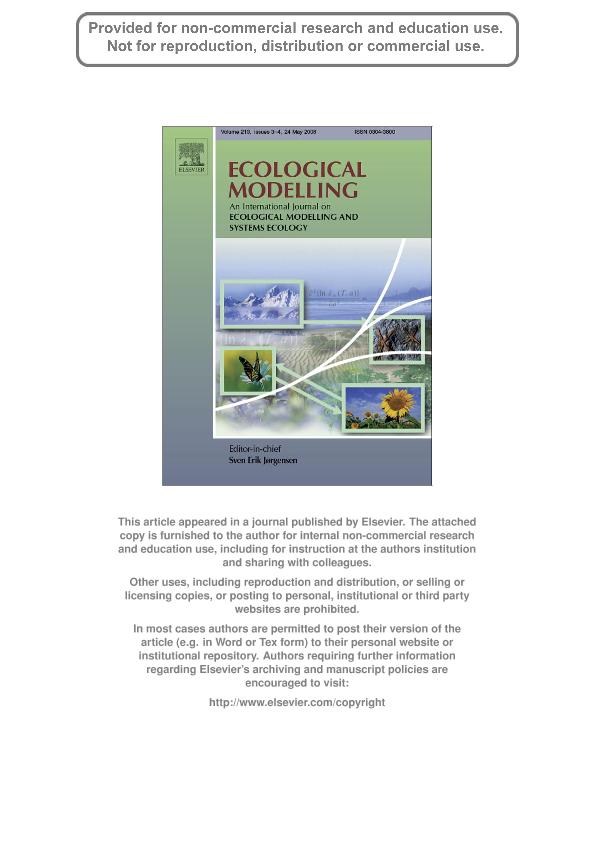Mostrar el registro sencillo del ítem
dc.contributor.author
Grilli, Mariano Pablo

dc.date.available
2022-06-06T13:37:09Z
dc.date.issued
2008-05
dc.identifier.citation
Grilli, Mariano Pablo; An area-wide model approach for the management of a disease vector planthopper in an extensive agricultural system; Elsevier Science; Ecological Modelling; 213; 3-4; 5-2008; 308-318
dc.identifier.issn
0304-3800
dc.identifier.uri
http://hdl.handle.net/11336/159000
dc.description.abstract
The "Mal de Río Cuarto" disease in maize is a viral disease caused by a reovirus (MRCV) and transmitted by the delphacid planthopper Delphacodes kuscheli Fennah in a persistent manner. Although the disease is endemic in only one provincial department, when regional outbreaks occur the losses in maize production are very significant. Actively dispersing D. kuscheli individualswere collected from 15 sampling sites during the 1999 and 2000 spring seasons using sticky traps placed at 6m above ground level, designed to detect flying individuals. Insect host patches were surveyed using Landsat 5 TM images for the periods studied. Two critical landscape metrics, total class area and mean proximity index, were calculated using FRAGSTATS 3.3 on the winter pasture satellite images. Amultiple regression model showed the relationship between host patch area, mean proximity index and D. kuscheli abundance to be highly significant (R2 = 0.96, r = 0.98, P < 0.0001). Spatial simulations of different host areas and different interpatch separations were created in order to test the effect of these metrics on the abundance of the dispersing individuals. The estimate of the insect?s abundance showed that, although patch size is very important in determining mean insect abundance in an area, the separation of these patches is crucial to establish the effect of host patch area on the abundance of dispersing individuals. Until now, disease management consisted in modifying sowing dates in order to avoid maximum D. kuscheli abundances and thus minimize risk of Mal de R´ıo Cuarto Disease. Our results show that a rational area-wide management of host patches can keep
dc.format
application/pdf
dc.language.iso
eng
dc.publisher
Elsevier Science

dc.rights
info:eu-repo/semantics/openAccess
dc.rights.uri
https://creativecommons.org/licenses/by-nc-sa/2.5/ar/
dc.subject
Disease Vector
dc.subject
Planhopper
dc.subject
Agricultural Pest
dc.subject
Landsat TM
dc.subject.classification
Ecología

dc.subject.classification
Ciencias Biológicas

dc.subject.classification
CIENCIAS NATURALES Y EXACTAS

dc.title
An area-wide model approach for the management of a disease vector planthopper in an extensive agricultural system
dc.type
info:eu-repo/semantics/article
dc.type
info:ar-repo/semantics/artículo
dc.type
info:eu-repo/semantics/publishedVersion
dc.date.updated
2022-06-03T18:34:09Z
dc.journal.volume
213
dc.journal.number
3-4
dc.journal.pagination
308-318
dc.journal.pais
Reino Unido

dc.journal.ciudad
Londres
dc.description.fil
Fil: Grilli, Mariano Pablo. Consejo Nacional de Investigaciones Científicas y Técnicas. Centro Científico Tecnológico Córdoba. Instituto Multidisciplinar de Biología Vegetal (P). Grupo Vinculado Centro de Relevamiento y Evaluación de Recursos Agrícolas y Naturales; Argentina
dc.journal.title
Ecological Modelling

dc.relation.alternativeid
info:eu-repo/semantics/altIdentifier/doi/http://dx.doi.org/10.1016/j.ecolmodel.2007.12.004
dc.relation.alternativeid
info:eu-repo/semantics/altIdentifier/url/https://www.sciencedirect.com/science/article/pii/S0304380007006345
Archivos asociados
